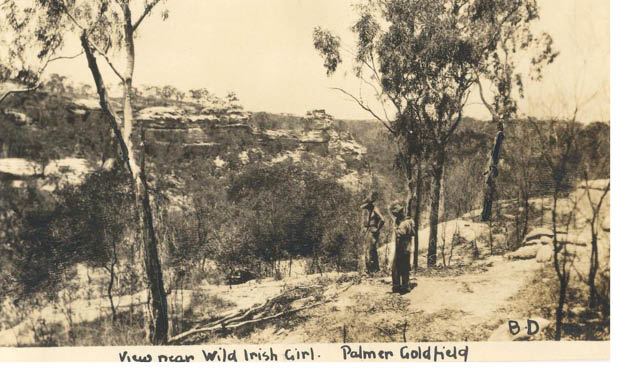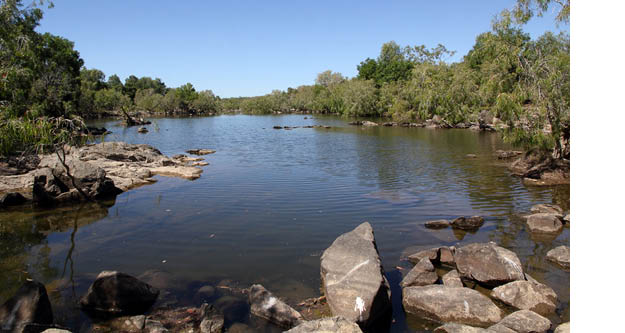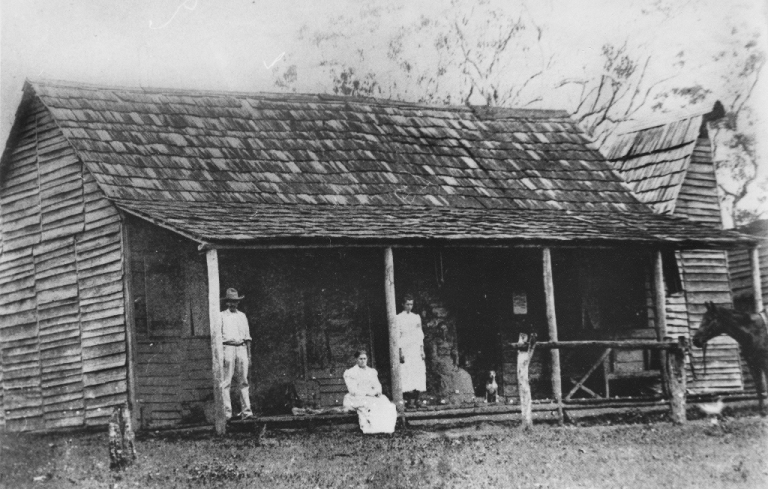Gold Rush on the Palmer River
If you wanted to cook up a wild adventure story, start with a Queensland river blessed with rich alluvial gold. Throw in a bunch of self-reliant prospectors, an uncontrolled stream of Chinese diggers, Martini-Henry rifles, spirited horses, and a tough indigenous nation that resented and fought the intrusion. Throw it all in a pressure-cooker of Cape York heat, and you’ve got the Palmer River Gold Rush.
In 1872, two brothers from Victoria, William and Frank Hann, along with a botanist, a geologist and others travelled north on a Queensland Government sponsored expedition to investigate the country “North to the 14th Parallel”. Rugged country even now, in those days Cape York was an area even the toughest settlers and adventurers avoided.
Hann located a river beginning in the hills west of Port Douglas, flowing westwards for six-hundred-kilometres before it emptied into the Mitchell River, ultimately reaching the Gulf of Carpentaria. He named this waterway the Palmer River after the Chief Secretary of Queensland, Arthur Palmer. Hann and his comrades were the first to pan gold from the river in 1872. The amounts were not significant, but enough to excite some interest back in civilization.

The lure of a brand-new find attracted James Mulligan, a tough Irishman scraping a living on the Etheridge fields, but dreaming of better things. Staking everything on the venture, he outfitted an expedition with five solid mates and rode north into the wilderness.
They returned to Georgetown, on the Etheridge fields, after weeks of panning the Palmer River gravels. It was September 1873, when the Mine Warden posted a notice on the walls of his hut: “JV Mulligan reports the discovery of payable gold on the Palmer River. Those interested may inspect at this office the 102 ounces he has brought back.”
Within a few days, just about every miner in the worked-out Etheridge field had started on the five-hundred-kilometre trek north. Prospectors knew that getting in early on a rush was the key. Some rode horses or perched on a wagon box. Others walked. Many pushed barrows loaded with all their tools and possessions.
Word went out by ship, telegram, word-of-mouth and mail. News reached Brisbane, Sydney, Melbourne, then Shanghai and San Francisco. The rush was on.
With the wet season not far away, authorities warned of fever, flooded rivers and trouble. Even Mulligan himself wrote to the Queenslander newspaper: “I do wish to stop this before it grows any more. Already exaggerated accounts and too much excitement exist here. If people rush the place without rations they must perish.”
Yet nothing dimmed the excitement, and when the Government opened a landing on the Endeavour River the gold-seekers poured in by boat as well.
From beginning to end, the Palmer River yielded a fantastic amount of gold. One hundred tons was the official count, but much more was taken away by the Chinese (gold prices were better in China) or carried home by diggers. It was a genuine El Dorado, but harsh beyond belief, and wild by any standards.
The local Merkin people were not nomadic by nature, rather in villages of bark-lined huts on the ridges near good hunting and fishing grounds. They went from living in a relatively unspoiled domain, to a hell-hole of shafts, camps, mullock heaps and fires. Trees fell to the axe, waterholes were muddied, and white men and their guns were everywhere. Some shot blacks on sight, and the strong, able spearmen retaliated.
A letter dated October 5, 1873 from an early arrival stated: “At present the blacks are very bad. It is war to the knife between the whites and them.”

Unsuccessful diggers, handy with their weapons, hired themselves out as bodyguards, standing sentry with their Martini-Henry or Snider rifles, watching for Merkin raiders. Two such characters were “Sam the Tracker” and Jack Martin, better known as “The Orphan.” Bored of earning a pittance standing guard for a party of Chinese diggers, the pair instead murdered and robbed the Chinese gold courier headed for Cooktown on his weekly run. With the law on their trail, the pair doubled back and stole seven of the pursuing police horses.
“The Orphan” was later noted for causing trouble, including cattle stealing, in the Gulf, but was never arrested for the Palmer River crimes. In Borroloola, during a drunken fight, he accidentally shot off his own thumb and forefinger.
The town of Palmerville slowly took shape with two stores. Stock was at a premium in the early days, however, and commodities like flour and beef sold out almost as soon as it arrived. The first pubs were basic affairs, little more than bark sheds, filled to capacity with brawling miners and echoing with arguments over territory, for there was no mine warden in the early days. The miners were prospecting for themselves in a free-for-all, centred mainly on the river itself. Gold lying in shallow depressions in the rapids could often be collected by hand. Exclusive territory came only through the use of fists, knives, and revolvers.
As the mining frenzy moved upstream, a new administrative and service centre was formed. This prosperous little settlement was called Maytown. The numbers of Chinese on the fields also exploded. In 1877 the population of the more important settlements was reported by Warden Selheim as follows:
Maytown, 900 Europeans and 800 Chinese.
Palmerville, 12 Europeans and 600 Chinese.
Jessop’s, 6 Europeans and 1000 Chinese.
Stony Creek, 16 Europeans and 1200 Chinese.
Byerstown, 16 Europeans and 800 Chinese.
The large numbers of Chinese compared to Europeans was a feature of the fields. They kept to themselves, to a large degree, often re-working areas
that the whites had already picked over. They built their own little Chinatowns, with joss houses and opium dens in narrow alleys amid mullock heaps.
The Chinese presence on the fields was not all incense and opium, however. At one stage, the Pekinese and Cantonese elements turned on each other in a frenzied battle that lasted for several days. It culminated in the building of a fort by miners from Macao, who moved in on disputed ground while the others were busy fighting.
With the fort under siege by up to 2000 Chinese miners, hundreds were wounded or killed, and only a determined troop of police stopped the fighting. Thirty ringleaders were arrested and charged, while the fight, known as the Battle of Lukinville, was largely ignored by the Australian public and later historians.
Despite the relatively small number of white miners remaining on the fields as the rush went on, the area continued to produce brash, larger than life characters.
The Palmer River was the birthplace of “Australia’s Annie Oakley,” Claudie Lakeland. Claudie’s father Billy was a goldfields character famous for battling both black and white, and prospecting deep into the wilds of Cape York where few other gold-seekers dared to go. Claudie grew up on horseback, and with a gun in her hand.

Her fame as a dead-shot grew, and as a young teen she was challenged to, and won, a shooting contest against the policeman from Coen, Roly Garraway. One of her tricks was shooting, with a rifle, pennies thrown into the air.
The notorious “Maori” Jack Reid and his wife Henrietta operated a store on the fields. Reid had crewed on a notorious blackbirder, the brigantine Carl in the South Pacific waters. This murderous career culminated with the slaughter of sixty captives when the crew saw a British destroyer approaching. The Carl’s officers, first mate and some other seamen were charged, though all had their death sentences commuted to life imprisonment. “Maori” Reid escaped these unpleasant consequences and enjoyed life in the wilder parts of Australia for many years, before dying alone in a hut near Pine Creek, NT, in the 1930s.
While reflecting on the adventurous characters who answered the call of gold, the saddest aspect of this gold rush was how it tore both a river system and the Merkin people apart. For the survivors and the landscape itself, nothing would ever be the same.
Gold was a terrible lure, and in reality, only a few diggers got rich in a life-changing way. For many, prospecting became a way of life, listening for the next whispered talk of a “find” in some distant and remote location; time to pack the saddle bags and head off, always in the hope of that elusive fortune.
Main photo: Goldfields hotel, 1870s. Courtesy State Library of Queensland.





1 Comment
My great grandfather (Edwin Taylor) took his wife (Sophia) and 2 year old daughter(Angelina) to the Palmer. He died of Remittant Fever (Malaria), leaving his wife alone with my grandmother. They left the fields 4 years later when great grandmother married the local shopkeeper (Patrick Fox).